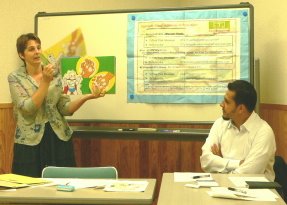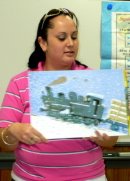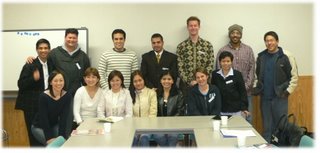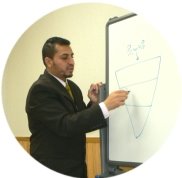Welcome to ETJ Miyazaki
Tuesday, March 17, 2015
Saturday, June 02, 2007
the 10th. meeting
ETJ Miyazaki's 10th Meeting"GAMES WITH FLASH CARDS FOR ALL SIZE GROUP AND AGES"The Miyazaki Regional Ggroup conducted it's 10th meeting with the topic "using Flash Cards" held last November 26,2006 from 10 am to 2:30 noon at the Kyoiko Johu Kensho Center,Miyazaki Board of Education,Miyazaki City. A total of 8 members and a 2 new comers participated in the said activity.The Presenter, Mr. Bradley Yaxley. This is his second time to be a presenter in the Miyazaki ETJ meeting.He introduced about how to use flash cards for all size group and ages.Flash cards is the most useful and readily available teaching aids.In this workshop we learned how to use flash cards in more interesting ways and encourage student s to participate in games and how to communicate more coherently.GAMES WITH FLASH CARDS
Bradley Yaxley Joey English School 1. What are you doing
??;/FONT>How to Play??;/FONT>
??;/FONT>Variation??;/FONT>
Noun FC Adjective FC wisehat.com/ index.php
amp;shy; going to the library.?ɦlt; /span>
??;/FONT>How to Play??;/FONT>
The student moves a toy car or token and may answer by telling the truth or lying. span> nbsp;(meaning you?Dze lying) or ?Èh, I see?ɦamp;nbsp; (meaning you?Dze telling the truth) The reply can be what ever you like as long as it?dz clear.
??;/FONT>Variation??;/FONT>
Noun FC Adjective FC
??;/FONT>How to Play??;/FONT>
??;/FONT>Variation??;/FONT>
Noun FC
Jump the line
Have the S make one or two lines, up to 10 S one line if more 2 lines. T shows S a FC and says the FC or lies and says something else. If the T tells the truth the S jump RIGHT / If the T tells a lie S jump LEFT. Any student not moving either left or right is automatically out and should sit out till the next round. Any S jumping the wrong way is also out. S who are slow to diced or just copying are also out. (ANY FC)(ABC)Are you?Ä¿ / Can you..? Do you?Ä¿ Game
Drill FC and question structure. And response. Are you adjective (happy)? Yes, I am / No, I?Ǧamp;shy; not. Display cards where all can see. Teacher secretly chooses one of the cards. S individually or together in teams try to guess the teachers card by asking ?Ère you?Ä¿?ɦamp;nbsp;First person or team to guess wins. Winner can take teachers place. Can you (use a verb) ? Do you (use have / like a noun)? (ADJ) Rabbit earsTeacher holds up 2 FC above his / her head and asks the students an appropriate question. I.e. if colors the teacher asks ?ȉs it blue??ɦamp;nbsp;S answer accordingly. The teacher keeps guessing until a correct guess is made. Then asks ?ȉs it this one??ɦamp;nbsp; etc. All students place 2 unseen FC above their heads. They take turns asking until they can guess correctly or the timer goes off. (ANY FC) (colors) Slow PullSlowly reveal the card upwards from behind the first student or team to guess or say correctly gets a point / chip or the card. Fast pace, most points, cards wins.Slam. Place cards on the table. Students place their hands on their heads. Teacher says a card first student to touch and say gets a point / chip.(can be played with 2 sets of cards at one time for more winners)Where is?Ä®?Place cards face down on the table. Teacher says where is ?Ä®.? Students take turns turning over cards saying each card as it is turned. Teacher says is it ?Ä¡Ä®? Elicit Yes/No. First student to find the designated card wins.Quick FlashQuick Flash Teacher quickly flashes the card to the students. First student to say wins.How many can you remember? (Class game) Students repeat after teacher x 1. Then students attempt to say as many cards as they can remember as the teacher shows them the cards. The teacher gives 1 point using a counter every time a correct answer is given by the majority of the class. The Teacher should set goals for the class before the game i.e. If doing 50 nouns explain by saying in English and writing on the board if necessary that if students remember 20 out of 50 they will receive 2 points / 30 out of 50 they will receive 3 points etcHigh card wins(For numbers or cards with numbers) Students are given a certain number of cards eg 7 cards each. They must not look at their cards. In pairs and in opposite teams the first 2 students turn over their cards and say what number (class repeat optional) The student with the high card wins. Elicit I win / I won. Then the next 2 students challenge each other. Repeat several times. After 2 – 5 mins stop the game and students count their cards most cards wins.
Tuesday, January 09, 2007
Tuesday, June 20, 2006
9th Meeting: Using Kamishibai (Story Cards) in the Classroom

The ETJ Miyazaki Regional Group conducted its 9th meeting with the topic: “Using Kamishibai (story cards) in the Classroom” held last June 11, 2005 from 10 am to 12 noon at the Kyoiko Johu Kenshu Center, Miyazaki Board of Education, Miyazaki City. A total of 17 ETJ members participated in the said activity.
Ms Erika Heijima introduced the concept of using Kamishibai, a traditional Japanese story telling using picture cards. She initially discussed the differences between the kamishibai and the classic story books everyone is familiar with. Her discussion delved on the advantages of using kamishibai over that of a story books. The criteria for choosing and translating a kamishibai, as well the various tips on how to get started were substantially discussed.
Since Kamishibai is a traditional Japanese material its accompanying text is also written in Japanese. Translating the whole (Japanese) text to English language is not advisable; rather she encouraged interpreting the pictures itself into a story, choosing a language that is suitable to the age group of the students.
To better expound the topic, Ms Heijima showed various examples of story cards that can be bought in most bookstores; likewise, she perkily demonstrated an actual kamishibai-story- telling that certainly captured the attention of the audience.
As part of the workshop, ETJ members were grouped into five(5); each group was given a Kamishibai to work with by translating the picture cards into a story. To highlight the meeting, each was asked to present their output to the whole group by telling a story using a Kamishibai.(Presenters from each group, from top to bottom, Ms. Tabitha Ferry, Kenyatta Carter, Bradley Yaxley, Sayed Mohamed with Miyuki Kawasoe and Shirley Takarabe)



___________________
Our sincerest thanks and appreciation to Ms Erika Heijima for generously sharing her time and expertise. We have gained new teaching insights and we certainly enjoyed the presentation. Ms Heijima is truly a brilliant story teller!
_____________________
Erika Hiejima is from Australia. She has a Bachelor Degree in Early Childhood Teaching and has been teaching young children abroad for 17 years. She has worked at Miyazaki English Kindergarten for the last 7 years. She has extensive knowledge especially in the usage of Kamishibai (story cards).
@Marley Tallada
Monday, March 20, 2006
8th Meeting: English in Elementary Schools
The ETJ Miyazaki had its 8th meeting with the theme: “English in Elementary Schools” held last Sunday
The presenter, Mr. Sayed Mohamed, is an ALT for the past 8 years and at same time manages his own 2 English Schools (OXFORD & SES). He willingly shared his expertise, his insights gained over the years of his teaching experience. His presentation delved on the highlights of the book he himself have authored entitled “Yaru, Shogakko no Eigo” .
He initially discussed the current elementary English curriculum, its problems and his recommended measures. Among the problems he identified include: lack of harmony between the ALT and HRT; lack of books, lack of workable lesson plan and lack of ALT’s experience, among others. His recommendations include: Formulation of an upgraded curriculum; creation of lively lesson plans; establishment of practical team teaching framework; use of various teaching tools, among others.
His presentation focused on team teaching and his suggested lesson plan which comprise of the following:
- Warming-up - includes greetings, basic question and answer, he emphasized addressing ALT’s using the titles Mr/ Ms/ Mrs. The HRT should take active part right at the start of the class by giving hints to the students especially in the QandA.
- Song - songs should suit with the grade level of the students; it must not be too long; should be related to the topic and should be an easy-to-follow song
- Vocabulary - vocabulary should not be the main topic of the class; it should be read first by the ALT, followed by the HRT, then repeated by the students; use of big flash cards and chant box highly recommended and the vocabulary should be used in the conversation (later part of the lesson)
- Phonics - proper pronunciation and blending of sounds esp. consonants should be introduced as part of the vocabulary; refrain from translating or rewriting English words in Katakana version.
- Conversation - role playing of the conversation should be done first by the ALT and HRT at least 3 times in three different levels of speed (slow, natural speed and fast); Practice of conversation using an inverted triangle model, which suggest the following scheme: a) practice as a whole class b) divide the class into two groups; c) further divide the class into smaller groups; then d) make pairs; and then finally (e) ask for student volunteers to demonstrate the conversation in front of the class
- Grammar – basic grammar notes should be stressed in the conversation, although it should not be taught directly.
- Game – games should be connected to the conversation or topic
- Closing - The HRT should again take active part in the final greetings before ending the class

Other suggestions include:
1. Make three (3) different levels of lesson plan that suits the grade level of the students e.g. Level I for grades 1and 2; Level II for grades 3 and 4 and level III for grades 5 and 6.
2. At the start of the class, request for a meeting among the HRT’s, the Principal and Assistant Principal in the school and propose for some changes in their current lesson plans applying the above mentioned scheme.
@Marley Tallada
Wednesday, December 14, 2005
7th Meeting: Reading Story Books to Young Learners
The last regional ETJ meeting was November 27th 2005.
The Topic was: "Reading story books to young learners".
Unfortunately due to many reasons, personal and others many members
were unable to attend. Despite the disappointing turn out some
positive things were discussed and resulted in some useful advice
and activities for reading story books to young learners.
TECHNICHES AND READING METHODS FOR SHARED READING
Suggested Procedures:
1. Picture focus reading.
Hold up the book and read the title twice while pointing to each
word. Students repeat the title x 2. Ask questions about the title and pictures on the cover E.g. What's this? What color is this? How many....? Etc Continue to turn the pages and discuss the pictures using graded language.
2. Action meaning focus.
Read the text but focus on the pictures. Have students point to the
objects that you refer to in the story. Ask questions that require
the students to explain the action etc. e.g. What is she doing?
Where is the dog? Do you like dogs? Etc.
3. Text focus.
Read and point to the text. Pause after each page and encourage
students to repeat the text. As k individual students to reads some
of the text. Ask the students comprehension questions. Point o the
word (cat). How many t's are there?, How do you spell dog? etc.
Encourage the students to read the book again by themselves.
4. Role playing.
Once a book has been read two or three times and the students are
familiar with the story, assign roles to each student and act out
the story. Alternatively, the teacher narrate the story and the
students act out the events only. e.g, running, making a cake,
eating etc.
Other general suggestions.
1. Remember to vary your voice and have fun
2. Choose age appropriate books
3. Choose short books
4. Choose colorful books with interesting or funny pictures.
5. Read picture books in class as much as possible
ACTIVITIES AND GAMES
GAME 1.
Pass the parcel - word reading game.
Preparation
A) Make Flash cards with the words from the text of the story.
B) Wrap a small present or some candy in newspaper or other paper.
C) Place a flash card on the out side of the wrapping paper.
D) Wrap the parcel again and again each time inserting a word flash
card between the layers.
Game Procedure
A) Arrange the students so that they are sitting in a circle.
B) Play some music or sing a song or chant
C) The students pass the parcel around while music is being played
or song / chant is being sung / said.
D) The music is stopped randomly and the person holding the parcel
has to read the word on the flash card from the story.
E) If the student can read the word, they can unwrap one layer and
the game repeats until the last player unwraps the present or
candies.
GAME 2.
Picture Book Puzzle
Preparation: Choose a book e.g "Brown Bear Brown Bear, What do you
see? Eby Eric Carle
A) Make flash cards (A4) with the pictures from the story. E.g
brown bear, red dog, green frog, etc.
B) Cut the flash cards so each flash card becomes 3 pieces making a
simple puzzle. You may choose to write the words on the same side as
the picture or on the back making 2 puzzles, one for pictures and
one for reading practice.
C) Make as many cards as you like according to how many pictures you
want to cover and how many students you have. In this book there are
10 pictures of animals. Is you wanted to use all of them you would
start with 10 A4 flash cards and after cutting them you would have
30. It's a good idea to have 2 or more sets for team games.
D) laminate the cards
Game procedure 1
A) Play as a whole class, working against a timer.
B) Spread the cars out on the floor or table (upside down.)
C) How fast can the class arrange the puzzle and say the Picture or
read the word.
Game procedure 2
A) Divide the class into teams.
For a small class of 6 students 2 teams of 3. For a large class of
32 students 4 teams of 8.
B) Give each team an equal number of matching flash cards.
C) Spread them out and place them upside down on the floor or desk(s)
D) Select one student from each team to call out a picture from the
book.
E) The first team to make the picture or word wins a point.
F) Repeat with other pictures and students.
GAME 3
Picture book basket
Preparation
Choose a book e.g "Brown Bear Brown Bear, What do you see?Eby Eric
Carle
Game procedure
It's just like fruits basket, but instead of using fruit, use
vocabulary from the picture book. Instead of calling out just a word
have the students ask a question or make a statement. I.e. "Do you
like green frogs? The students who answer, Yes, I do. Change seats.
A) Arrange the students so they are sitting in a large circle on
their chairs.
B) A student or the teacher stands in the middle and says “Do you
like green frogs?”
C) All students answer with Yes, I do or No, I don't
D) The students who answered Yes, I do Exchange seats.
E) The student standing in the middle quickly sits down and a new
student is in the middle
F) The new student asks a new question. Using flash on the board
with magnets will help students to remember.
GAME 4 .
Slow Peek
Preparation: Choose a book e.g Brown Bear Brown Bear, What do you
see? Eby Eric Carle
A) Make flash cards (A4) with the pictures from the story. E.g
brown bear, red dog, green frog, etc.
Game procedure
A) Slowly reveal the card upwards from behind.
B) The first student or team to guess or say correctly gets a
point / or the card.
C) Fast pace, most points, cards wins
GAME 5 .
Quick Flash
Preparation: Choose a book e.g Brown Bear Brown Bear, What do you
see? Eby Eric Carle
A) Make flash cards (A4) with the pictures from the story. E.g
brown bear, red dog, green frog, etc.
Game procedure
A) Teacher quickly flashes the card to the students.
B) First student to say wins
GAME 6.
Run and get it
Preparation: Choose a book e.g "Brown Bear Brown Bear, What do you
see? Eby Eric Carle
A) Make flash cards (A4) with the pictures from the story. E.g
brown bear, red dog, green frog, etc.
Game procedure
A) Dived class into 4 or 2 teams. Line them up at one end of the room
B) Place flash cards upside down randomly on the floor at one end of
the room.
C) The first 4 students, 1 from each team stand up.
D) After the Teacher calls out the Flash card students race to find
the corresponding card.
E) Once found the student must say the Flash Card.
F) Cards are given as points or put back and points given
separately.
G) Students go to the end of the line the next 4 stand up.
See you at the next meeting
Bradley Yaxley




